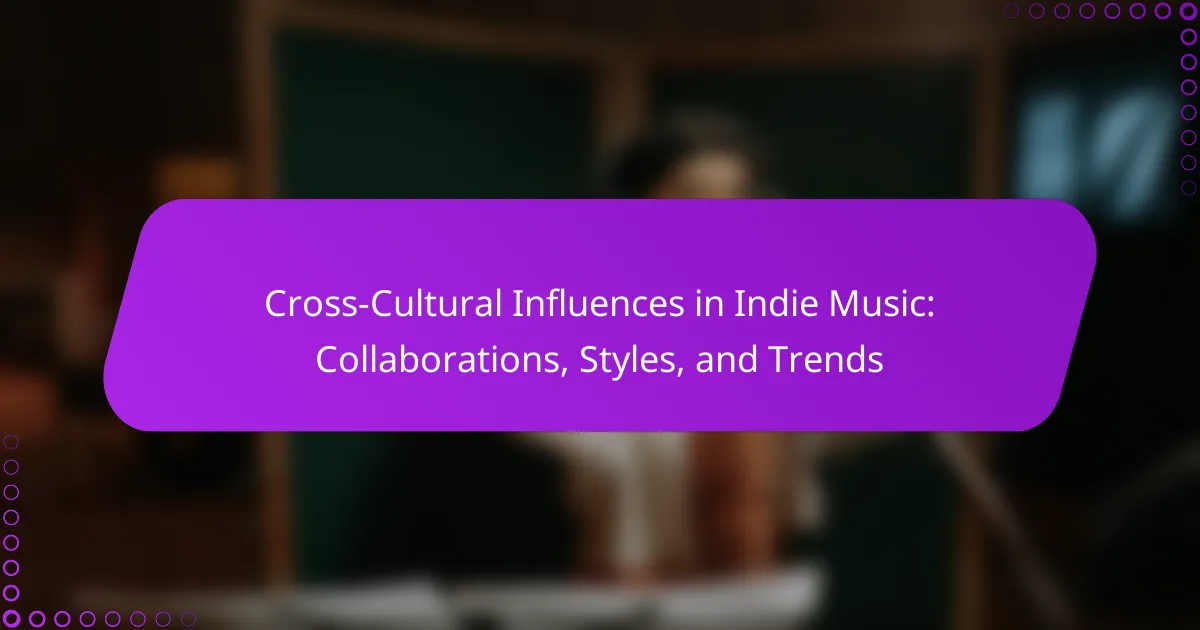Cross-cultural influences in indie music create innovative sounds that appeal to diverse audiences. Collaborations blend traditional instruments with contemporary genres, enriching the indie soundscape. Regional trends reflect unique cultural narratives and social dynamics. Understanding these influences fosters authenticity and broadens the reach of indie artists globally.
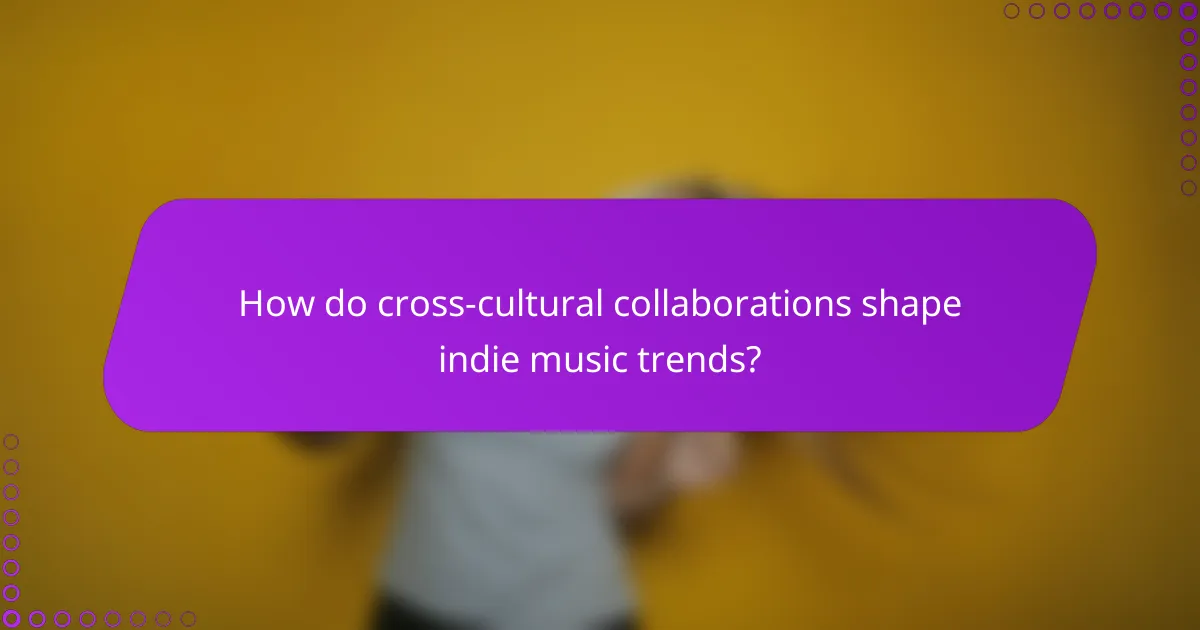
How do cross-cultural collaborations shape indie music trends?
Cross-cultural collaborations significantly shape indie music trends by blending diverse musical styles and cultural influences. These partnerships foster innovation, leading to unique sounds that resonate globally. For instance, artists from different backgrounds often merge traditional instruments with contemporary genres, creating fresh auditory experiences. This fusion not only expands the artistic palette but also attracts wider audiences, enhancing the global reach of indie music. As a result, trends evolve, reflecting a rich tapestry of cultural narratives and shared experiences.
What are the key influences from different cultures in indie music?
Cross-cultural influences in indie music stem from various global traditions, styles, and collaborations. Artists often blend elements from different cultures, creating unique sounds that reflect diverse heritages. For example, the incorporation of African rhythms in Western indie tracks showcases a fusion of musical techniques. Additionally, collaborations between artists from distinct backgrounds lead to innovative genres, such as the mix of Latin and folk influences. Trends like these highlight how indie music serves as a platform for cultural exchange, promoting inclusivity and artistic growth.
Which artists exemplify successful cross-cultural collaborations?
Artists like Yo-Yo Ma, Thundercat, and Anoushka Shankar exemplify successful cross-cultural collaborations in indie music. These artists blend diverse musical styles, creating unique sounds that resonate globally. For example, Yo-Yo Ma’s Silkroad Ensemble features musicians from various cultural backgrounds, merging traditional and contemporary influences. Similarly, Thundercat incorporates elements of jazz, funk, and R&B, showcasing a fusion of genres that reflects cross-cultural interactions. Anoushka Shankar’s work combines Indian classical music with Western styles, illustrating the rich potential of collaborative artistry.
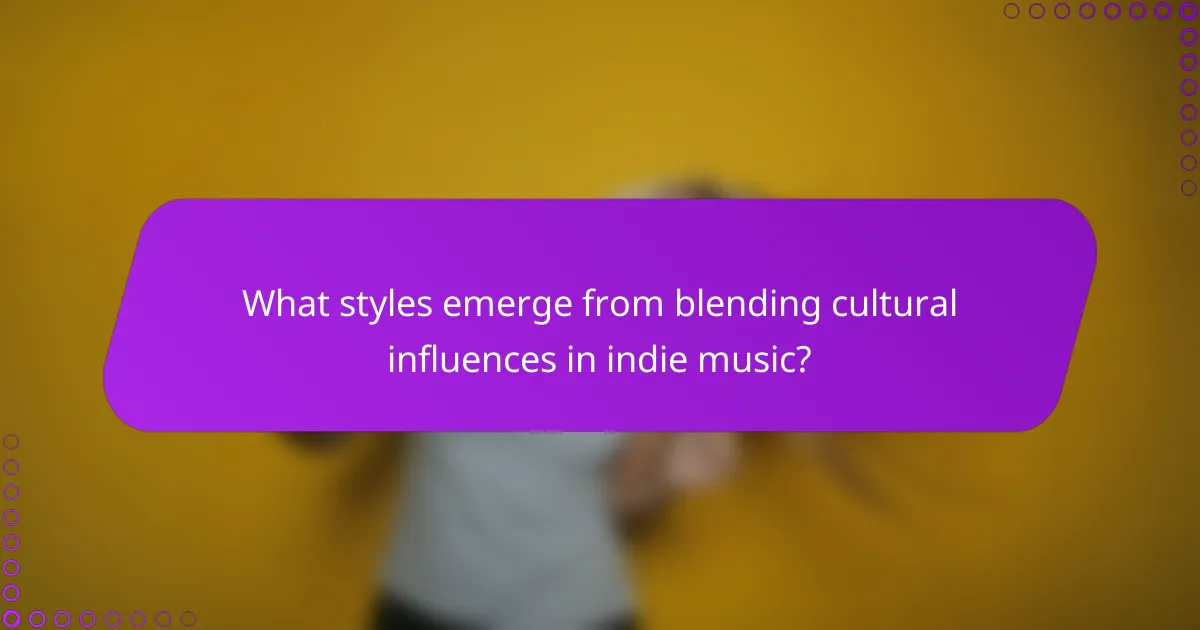
What styles emerge from blending cultural influences in indie music?
Blending cultural influences in indie music creates diverse styles, including fusion genres like folk-punk and worldbeat. These styles emerge from collaborations that incorporate traditional instruments and rhythms, enriching the indie soundscape. Unique attributes, such as regional folk influences, differentiate specific artists and tracks. As a result, indie music evolves with each cultural blend, reflecting global diversity.
How do musical genres interact in cross-cultural indie collaborations?
Cross-cultural indie collaborations fuse diverse musical genres, creating innovative sounds and expanding audience reach. These interactions often blend traditional elements with contemporary styles, resulting in unique fusions. For instance, a collaboration between an African artist and a European indie band may incorporate local rhythms with modern instrumentation. This approach not only enhances cultural exchange but also attracts varied listener demographics, promoting inclusivity in music. Furthermore, such collaborations can lead to the emergence of new sub-genres, reflecting the artists’ diverse backgrounds and experiences.
What role do traditional instruments play in modern indie music?
Traditional instruments significantly enrich modern indie music by adding unique textures and cultural depth. They foster cross-cultural collaborations, blending diverse musical styles. For instance, the use of sitars, djembes, or flutes can create innovative soundscapes that differentiate indie tracks. This incorporation enhances authenticity and connects listeners to various cultural narratives, reflecting a growing trend in the genre.

Why do certain cultural trends resonate more in specific regions?
Certain cultural trends resonate more in specific regions due to historical context, social dynamics, and local influences. Indie music thrives on cross-cultural collaborations that reflect these unique regional characteristics. For example, artists from different backgrounds may blend distinct styles, creating a sound that appeals to local audiences while introducing global elements. The fusion of genres can attract diverse listeners, enhancing the trend’s resonance. Additionally, regional festivals and music scenes can amplify these collaborations, making them more relevant and accessible. This interplay between local culture and global influences shapes the indie music landscape, fostering trends that reflect the unique identity of each region.
How does audience perception vary across cultures?
Audience perception varies significantly across cultures due to differing musical tastes, social values, and historical contexts. For instance, indie music collaborations often reflect local traditions, which influence how audiences interpret styles and trends.
In Western cultures, indie music tends to prioritize individual expression and innovation, leading to a perception that values originality. Conversely, in collectivist cultures, the emphasis may be on community and shared experiences, shaping a preference for collaborative works that resonate with cultural narratives.
Additionally, regional trends can affect audience reception. For example, indie music in Asia might incorporate traditional instruments, creating a unique fusion that appeals to local listeners. This cultural integration can enhance emotional connections and alter perceptions of authenticity.
Overall, understanding these cultural nuances is crucial for artists aiming to engage diverse audiences effectively.
Which festivals highlight cross-cultural indie music?
Festivals that highlight cross-cultural indie music include the World Music Festival, WOMAD, and the GlobalFest. These events showcase diverse genres and encourage collaborations among artists from various cultural backgrounds. They emphasize unique musical styles and foster trends that blend traditional and contemporary influences.

What are the unique attributes of indie music influenced by specific cultures?
Indie music influenced by specific cultures showcases unique attributes that reflect diverse musical traditions. These attributes include distinctive instrumentation, lyrical themes, and fusion of genres. For instance, the incorporation of traditional instruments like the sitar or djembe creates a unique sound. Lyrical content often explores cultural narratives and social issues, offering authenticity. Collaborations between artists from different backgrounds foster innovative styles, blending elements that resonate with varied audiences. This cross-cultural exchange enhances the richness of indie music, making it a vibrant and evolving genre.
How does language impact lyrical content in cross-cultural indie songs?
Language significantly shapes lyrical content in cross-cultural indie songs by influencing themes and emotional resonance. Different languages carry unique cultural contexts and expressions, allowing artists to convey diverse narratives. For example, a song in Spanish may evoke deep familial ties, while English lyrics might focus on individualism. This interplay enhances the richness of indie music, fostering collaboration across cultures. Additionally, the rhythm and phonetics of a language can affect melody and flow, creating distinct musical styles. Ultimately, language serves as a bridge, connecting varied artistic influences and enhancing the global appeal of indie music.
Which cultural narratives are commonly explored in indie music?
Indie music commonly explores cultural narratives that reflect diverse experiences and backgrounds. Themes often include identity, migration, and social justice, showcasing cross-cultural influences through collaborations and varied musical styles. Many artists draw inspiration from traditional sounds, blending genres to create unique expressions. For instance, the fusion of folk elements with electronic beats highlights cultural intersections. This trend fosters a rich dialogue about heritage and contemporary issues, resonating with audiences globally.
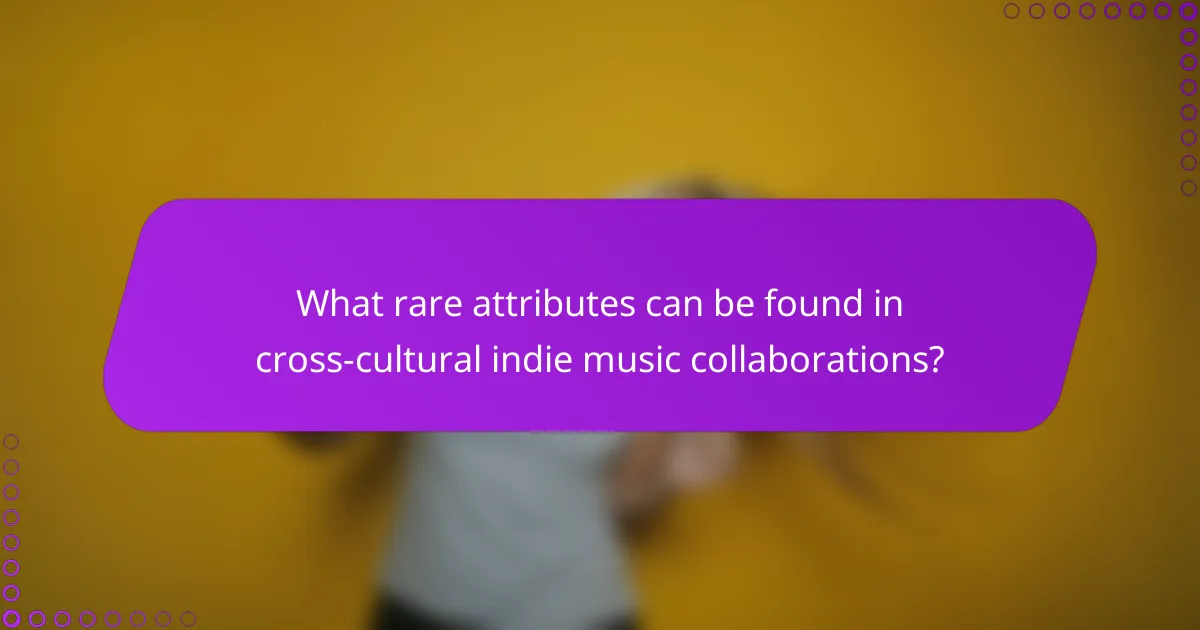
What rare attributes can be found in cross-cultural indie music collaborations?
Rare attributes in cross-cultural indie music collaborations include unique instrumentation, blending of traditional and modern genres, and the incorporation of indigenous languages. These collaborations often showcase distinct cultural narratives and innovative production techniques. Such attributes create a rich tapestry of sounds that reflect diverse artistic expressions and foster global connections.
How do specific collaborations challenge traditional music norms?
Collaborations in indie music challenge traditional norms by blending diverse cultural elements. These partnerships create innovative sounds that defy genre boundaries, promoting inclusivity and experimentation. For instance, artists from different backgrounds merge styles, resulting in unique musical fusions. This approach reflects a shift towards global influences, reshaping listeners’ expectations and expanding the definition of authenticity in music.
What unexpected genres or styles emerge from unique cultural fusions?
Cross-cultural influences in indie music lead to unexpected genres that blend traditional elements with modern styles. Collaborations often result in unique sounds, such as Afrobeat-infused rock or folk music with electronic elements. These fusions create fresh trends that challenge conventional genre boundaries and attract diverse audiences. For example, the rise of Latin trap integrates hip-hop with reggaeton, showcasing a vibrant cultural exchange. Another instance is the merging of traditional Indian instruments with indie pop, resulting in innovative musical expressions. Such genre fusions reflect the dynamic nature of global music and promote cultural appreciation.
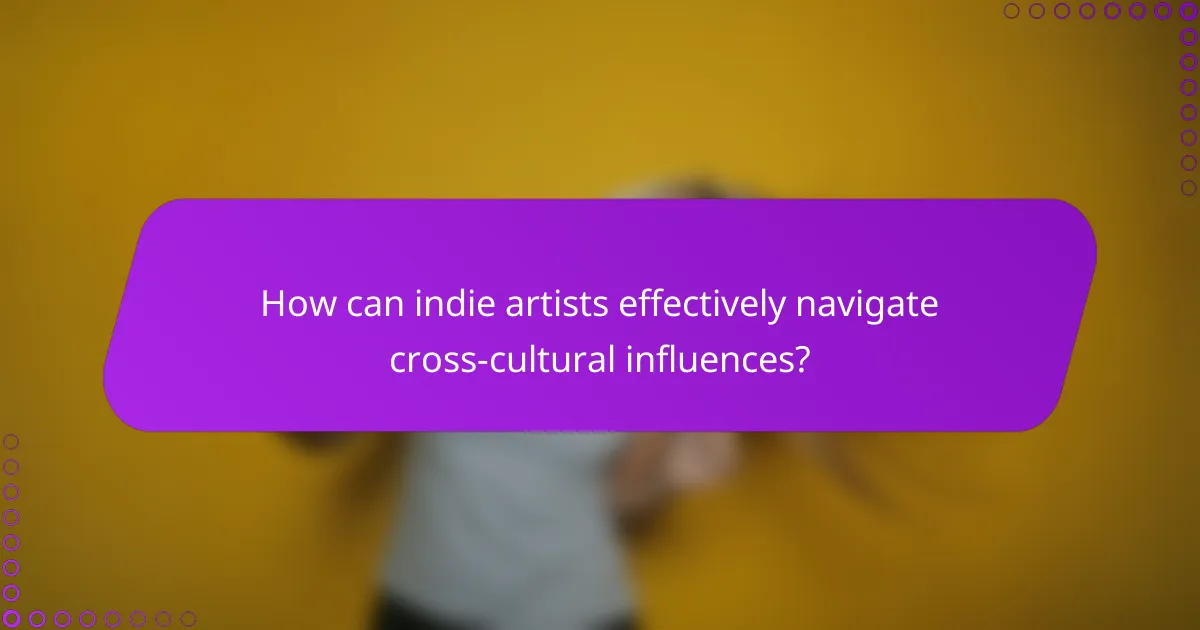
How can indie artists effectively navigate cross-cultural influences?
Indie artists can effectively navigate cross-cultural influences by embracing diverse musical styles and collaborating with international musicians. This approach enriches their sound and broadens their audience.
Collaborations with artists from different cultural backgrounds can introduce unique elements, creating innovative music that resonates with a wider demographic. For instance, blending traditional instruments with modern genres can result in fresh, appealing sounds.
Understanding cultural contexts enhances authenticity in music creation. Artists should research and respect the traditions they draw from, ensuring their work honors those influences. This respect fosters genuine connections with listeners.
Staying updated on global trends allows indie artists to adapt and evolve their music. Engaging with various cultural scenes through festivals and online platforms can inspire new ideas and collaborations, keeping their work relevant and dynamic.
What strategies can artists use to authentically represent diverse cultures?
Artists can authentically represent diverse cultures by engaging in genuine collaborations and research. They should prioritize understanding cultural contexts and histories.
Incorporating traditional instruments and styles into modern compositions fosters authenticity. Artists can also participate in cultural exchange programs to deepen their understanding.
Respecting and accurately portraying cultural narratives prevents appropriation. Engaging with cultural representatives ensures that representations are respectful and informed.
Lastly, artists should highlight their influences, creating a dialogue about cultural intersections in their work. This openness promotes appreciation and understanding among diverse audiences.
What common mistakes should artists avoid in cross-cultural collaborations?
Artists should avoid cultural appropriation, miscommunication, and lack of research in cross-cultural collaborations. Cultural appropriation can lead to offense and undermine authenticity. Miscommunication may arise from language barriers, affecting collaboration dynamics. Additionally, insufficient research on cultural contexts can result in misunderstandings and missed opportunities for deeper connections. Emphasizing mutual respect and understanding enhances the collaborative process and enriches the artistic output.
What best practices enhance the success of cross-cultural indie music projects?
Successful cross-cultural indie music projects thrive on collaboration, cultural sensitivity, and shared creative vision. Engaging local artists enhances authenticity and fosters community connections. Embracing diverse musical styles can enrich the sound and appeal to broader audiences. Utilizing social media platforms effectively promotes projects and connects with fans globally. Establishing clear communication among collaborators ensures alignment on goals and expectations, minimizing misunderstandings.
